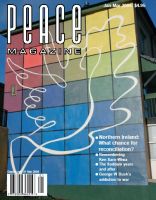
Peace Magazine Jan-Mar 2006, page 11. Some rights reserved.
Search for other articles by Dean Clark here
Art, Interactivity and Hope Shape a Peace Centre
Oslo, Norway
Sensors pick up that I'm moving close to the monitor and Mother Teresa's image flickers to life. The Nobel laureate's words on how to start making peace begin to crawl across a small screen: "Do not wait for leaders, do it alone, person to person." I'm standing in the "Nobel Field," the central installation at the just-opened Nobel Peace Center in downtown Oslo. Multi-media profiles of all the Peace Prize laureates surround me in the space, their video monitors floating, blossom-like, on thin metal stems above a field of small points of light.
Outside, the sun is making its feeble winter appearance, but I can still easily see out the Center's windows, across the fjord to the brick towers of the Radhuset, Oslo's City Hall and most famous peace symbol. Every December, amidst a modicum of pomp in this deeply modest society, King Harald awards the Nobel Peace Prize in the Radhuset's grand atrium.
This tiny country, with just 4.5 million people, has for years made an outsized contribution to world peace. In addition to determining the winner of the Peace Prize, Norwegian diplomats (greatly helped by revenue from North Sea oil) have played important roles in reaching negotiated settlements in hot spots like the Middle East, Sri Lanka and Sudan.
So, in a world beset by dozens of wars and rising military spending, it seems at once a touch quixotic, deeply hopeful and completely in character for Norwegians to spend 180 million kroner (about $28 million) on a high-tech visitor center dedicated to peace.
Nobel management brought in top international design talent to try to create something really new - a "living arena" to tell the laureate's stories, as described by Geir Lundestad, director of the Norwegian Nobel Institute. Nigerian-British architect David Ajaye was commissioned to create the Nobel Field and to mold the Center's two floors of fresh, open and sharply modern spaces for artwork out of the site, a former train station.
What's actually on display in these spaces is surprising. I expected to see famous artifacts, like Nelson Mandela's prison shirt, for example, and came up empty. Not a scrap on the premises. That's because Nobel planners ruled out traditional museum exhibits, deciding they would be too static. "We took the word museum out of project proposals early on," said Project Director Greta Jarmund. "In fact there will be only one artifact in the Center; a single Peace Prize medal." That kind of thinking led to some radical choices. The result is that rather than just look on through museum glass, you're invited to touch, listen and wander through some of the latest in multi-media artwork.
It's clear that the interactive and poetic heart of the Center is Ajaye's Nobel Field, where you can roam through a garden of touch-screen monitors to choose information on Mother Teresa, Nelson Mandela, Martin Luther King, Jr. and every other laureate. From there, walk into an alcove where you can lay hands on David Small's "interactive book" covering the life of Alfred Nobel. From a distance, this piece appears to be nothing more than an oversized blank book. But closer up, you find interactive text projected onto the page from above. Touch a headline about Nobel's life on the page, and the text morphs into new detail.
But nothing to do with peace is ever easy, it seems. Even something as non-controversial as a Nobel Peace Center faces some challenges here. Critics have been watching closely to see if balanced approaches to controversial laureates such as Yasser Arafat and Henry Kissinger are presented in exhibits. It won't be easy, either, to keep the enormous prestige of the Peace Prize intact while wrestling with economic realities of running the Center. The Norwegian government paid most of the bill for construction, but corporate and private donations totaling nearly 60 million kroner, (about $9,300,000) were needed to fully fund the job. Finally, some visitors may be put off by the 60 kroner (about $9.30) entry fee for adults (children under 12 are free).
It could be, though, that the financial challenges are part of a larger lesson; in the real world, maybe peace isn't free. And despite the hurdles, the need for a place that can inspire dialogue and negotiation is made clear by just picking up a newspaper, says Project Director Jarmund. Perhaps it was Wangari Maathai, the 2004 Peace Prize laureate, who summed up the Nobel Commission's aspirations best when she spoke at the Center's opening ceremonies in June. The point of these exhibits, she said, is to inspire us all "to take action to make your world a more peaceful place."
Dean Clark is a freelance journalist in Europe.

Peace Magazine Jan-Mar 2006, page 11. Some rights reserved.
Search for other articles by Dean Clark here